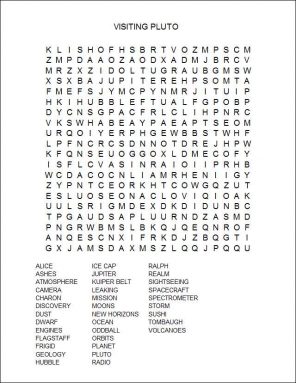Visiting Pluto
A NASA spacecraft is about to fly by the solar system’s favorite dwarf planet
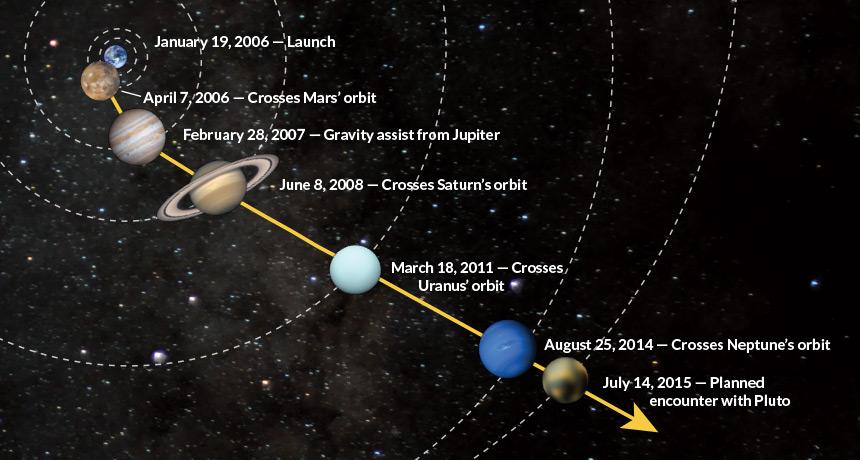
The New Horizons spacecraft is completing a 9.5-year, 5-billion-kilometer trek across the solar system to spend a few hours with Pluto and its moons. The probe will tear past the dwarf planet on July 14.
Image: Adapted from NASA, JHUAPL, SWRI; photo illustration by M. Telfer; background: NASA; Planets: JPL-CALTECH/NASA; JPL-CALTECH/NASA, MSSS; JPL-CALTECH/NASA, Univ. of Ariz.; NASA, JHUAPL, Carnegie Inst. of Science; NASA & Hubble Heritage
On July 14, tiny, far-flung Pluto is about to have a visitor — at least for a few hours.
NASA’s New Horizons spacecraft is speeding toward the dwarf planet. Earlier probes had flown past, orbited, crashed into or landed on every other large world that orbits the sun. Now Pluto is getting its turn.
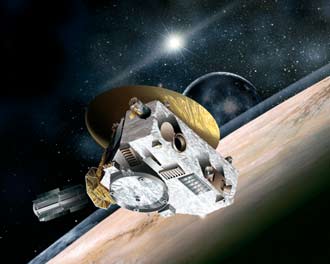
The probe also will explore why Pluto’s tenuous atmosphere is leaking into space. Pluto’s tiny moons may even provide a peek at what the building blocks of the planets look like.
“This is the last picture show,” says planetary scientist S. Alan Stern. The mission’s leader, he works for the Southwest Research Institute in Boulder, Colo. The Pluto fly-by, Stern says, is “the capstone moment to the reconnaissance of the planets.”
Pluto is the doorway to the solar system’s “third zone” — the Kuiper (KY-per) belt. It’s an icy junkyard beyond Neptune. Far from the meddlesome heat of the sun, Pluto swims in a sea of frozen celestial fossils. These rocks and other debris remain little changed since the birth of the solar system 4.6 billion years ago.
But the space probe’s visit will be brief. In short order, New Horizons will leave Pluto behind, vanishing into the frigid darkness beyond.
Pluto mania
Anticipation of the Pluto encounter has been building. “For a lot of people, this is something completely new — to see a point of light become a real place overnight,” says Stern.
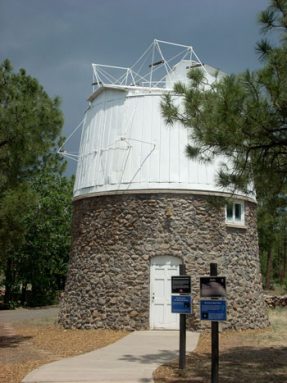
Stroll downtown to a local coffee shop in Flagstaff today and you can order a Pluto Mocha. From there it’s a five-minute walk to a sushi place for Pluto Rolls. A boutique around the corner sells handcrafted Pluto ornaments — one batch made before New Horizons’ arrival and one planned for after.
For most of the last 85 years, our view of Pluto hasn’t changed much (except, perhaps, for debates about whether it qualifies as a “planet”). From Tombaugh’s vantage point, Pluto was a mere speck of light, slowly wandering against a backdrop of stars. For the generations of astronomers with bigger and better telescopes that followed, Pluto still was little more than a mostly featureless spot on the sky.
But in 1989, plans for visiting Pluto began in earnest. Several ideas for a mission came and went. Indeed, it was tough to justify flying to so remote a place.
Mike Brown is a planetary scientist at the California Institute of Technology in Pasadena. Initially, he says, “I wasn’t entirely certain what to think about the New Horizons mission.” Ordinarily, he says, “You learn by studying examples of things. If there was nothing else like Pluto, why go to this oddball?”
And indeed, Pluto had always seemed an oddball. The tiny ice-coated body moved through an orbit that carried it far above and well below the plane of the solar system. It even has the audacity to cross the orbit of another planet: Neptune.
Then, in 1992, something happened that kicked off a decade of discovery. Suddenly, Pluto really seemed worth visiting.
“What really put this over the top,” Stern explains, “was the discovery of the Kuiper belt.” Planetary scientists David Jewitt and Jane Luu spied a small body orbiting beyond Neptune. It was the first confirmed body in the Kuiper belt. Until then, this belt was only a hypothesized ring of frozen debris encircling the sun.
At once, Pluto was no longer an oddity. It and Charon were merely the best-known ambassadors to an uncharted realm of the solar system. Researchers have since cataloged more than 1,300 icy boulders tumbling about the Kuiper belt. Scientists suspect there could be a trillion more.
With the discovery of the Kuiper belt, a National Academy of Sciences report in 2003 concluded that a mission to Pluto and Charon “should be NASA’s highest priority for medium-size missions in the decade 2003 – 2013.” New Horizons launched three years later, about eight months before the International Astronomical Union kicked Pluto out of the planet club.
In a hurry
New Horizons launched on January 19, 2006. When it left Earth, it was traveling about 58,000 kilometers (36,040 miles) per hour. In fact, it was the fastest spacecraft ever to leave Earth. (At its speed, a flight from New York to Los Angeles would take about four minutes). New Horizons crossed the orbit of the moon nine hours after its launch. For comparison, when the Apollo 11 astronauts journeyed to the moon, it took them almost three days.
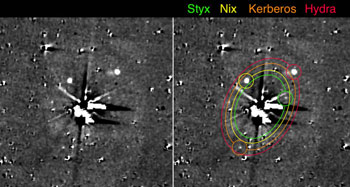
The planet is always frigid. On a warm day, its temperature peaks at −223° Celsius (-369.4° Fahrenheit). But since 1989, Pluto has been moving farther from the sun along its orbit — and cooling. Pluto gets so cold that its atmosphere might freeze for most of its 248-year trip around the sun. So New Horizons needed to arrive before 2020. That’s when Pluto’s atmosphere could become a giant ice shell. And this might keep the probe from seeing the dwarf planet’s surface and any storms or activity in its atmosphere.
Unfortunately, it’s impossible for the spacecraft to slow down once it arrives. So it will cross the face of Pluto in just under three minutes. The good news: For a few days it still will have been close enough to map its surface.
New Horizons has spent most of its trek to Pluto asleep. Once a year, mission engineers checked its instruments and electronics. In early 2007, the vessel got its first in-space practice run as it sidled up to Jupiter for a speed boost. The planet’s gravity grabbed the spacecraft and flung it into the outer solar system. At Jupiter, mission scientists also did a little sightseeing. They tested out the probe’s cameras and instruments on Jupiter and four of its moons.
Afterward, the spacecraft still had almost eight years of cruising to go, silently crossing the orbits of Saturn, Uranus and Neptune. Finally, last December, engineers woke the probe. It was now about 260 million kilometers (roughly 162 million miles) from its destination.
Snapshots galore
This past January, New Horizons began sending back early pictures of Pluto. They began as a trickle and will temporarily become a flood. The first images depicted a gradually brightening white smudge. Eventually, Pluto’s four smaller moons came into view. The last of them emerged in April.
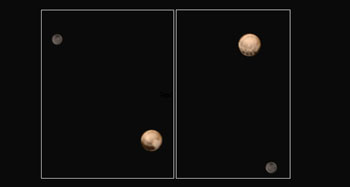
A bright spot at the dwarf planet’s north pole hints at a polar ice cap. From mid-May to July 14, every new image will be the best ever acquired of the Pluto system.
But New Horizons isn’t just photographing the dwarf planet. An ultraviolet spectrometer nicknamed Alice will study Pluto’s atmosphere. This instrument will use ultraviolet emissions from the atmosphere to analyze its chemical makeup, density and temperature. Alice also will measure how quickly the atmosphere is leaking into space. The spacecraft’s main camera, dubbed Ralph, will map the surface of Pluto and its moons. And a telephoto camera, known as LORRI — for Long Range Reconnaissance Imager — can zoom in for a really close look.
The spacecraft also carries a radio dish that’s 2.1 meters (roughly 7 feet) wide. It does double duty. It can send transmissions back and forth to Earth. It also serves as another probe of Pluto’s atmosphere. Two other instruments will monitor charged particles flying away from both Pluto and the sun. And a detector built by college students (an array of plastic films the size of a cake pan) is recording impacts with interplanetary dust during most of the long trek.
On July 12 and 13, New Horizons will send highlights of its most recent investigations.
Then it will go quiet for almost a day. It will simply stop communicating with Earth.
It’s a matter of priorities. To send data back, New Horizons needs to point its radio dish at Earth. But if the camera wants to aim at one of Pluto’s moons, for example, the whole probe needs to turn. Time spent talking with Earth is time not spent studying Pluto and its moons.
But if all goes well, New Horizons will phone home around 9 p.m. Eastern time on the July 14. It will send its first image on the following day. Encoded in radio waves, it will take about 4.5 hours to reach Earth. This should offer the first up-close glimpse of one of the most remote worlds in the solar system.
No one knows what it might show.
Unveiling the mystery world
“I think we’re all hoping to find some signs of active geology,” says William McKinnon. For instance, it might show signs of volcanic activity. McKinnon is a planetary scientist at Washington University in St. Louis. The large bodies in the Kuiper belt are planets in all but name, he notes. “They have histories, and geologies, and active atmospheres, and weather and all sorts of interesting things going on.” The shape of Pluto, he says, may even betray the presence of a core or a hidden ocean.
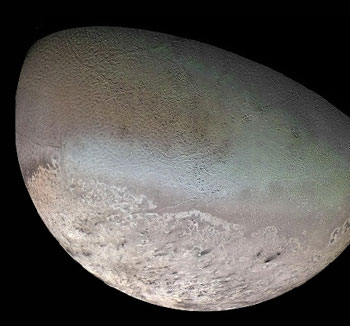
While his team is itching to see what Pluto is all about, it also expects to end up with a twinge of sadness. After working on New Horizons for 26 years, says Stern, it will be strange to not be looking forward to its arrival at Pluto. “For most of us,” he says, “it’s the only time we will be on a first mission of exploration where we go from knowing almost nothing to just a completely different universe, scientifically.”
But the mission doesn’t end in July. Its data won’t finish downloading until late 2016. And they undoubtedly will take years more to digest. Plus, Stern and colleagues have plans for New Horizons to visit more distant shores.
Using the Hubble Space Telescope, scientists have identified two other potential stops for the spacecraft in the Kuiper belt. Each is roughly 2 billion kilometers (1.24 billion miles) beyond Pluto. They lie in different directions. So scientists will have to choose between them. Stern says his team will make that decision with NASA in August, then fire up New Horizons’ engines for the next phase of its journey.
After that, the probe will continue to fly on into deep space. Should intelligent life ever encounter the craft, they might find signs of who sent it. New Horizons is carrying flags, coins, a postage stamp and other mementos. Among these will be an ounce of Clyde Tombaugh’s ashes.
This means the Flagstaff astronomer is finally getting to visit the world he discovered 85 years ago.
Power Words
(for more about Power Words, click here)
astronomy The area of science that deals with celestial objects, space and the physical universe as a whole. People who work in this field are called astronomers.
celestial (in astronomy) Of or relating to the sky, or outer space.
celestial object Any naturally formed objects of substantial size in space. Examples include comets, asteroids, planets, moons, stars and galaxies.
debris Scattered fragments, typically of trash or of something that has been destroyed. Space debris, for instance, includes the wreckage of defunct satellites and spacecraft.
dwarf planet One of the solar system’s small celestial objects. Like a true planet, it orbits the sun. However, dwarf planets are too small to qualify as true planets. Prime examples of these objects: Pluto and Ceres.
engineer A person who uses science to solve problems. As a verb, to engineer means to design a device, material or process that will solve some problem or unmet need.
geology The study of Earth’s physical structure and substance, its history and the processes that act on it. People who work in this field are known as geologists. Planetary geology is the science of studying the same things about other planets.
Kuiper belt An area of the solar system beyond the orbit of Neptune. It is a vast area containing leftovers from the formation of the solar system that continue to orbit the sun. Many objects in the Kuiper belt are made of ice, rock, frozen methane and ammonia.
moon The natural satellite of any planet.
National Academy of Sciences, or NAS Established by an Act of Congress, and then signed into law by President Abraham Lincoln in 1863, the National Academy of Sciences is charged with providing independent, objective advice to the nation on all matters related to science, technology and medicine. Sister organizations — the National Academy of Engineering and National Academy of Medicine — were set up in 1964 and 1970, respectively. Together, they serve as the National Academies of Sciences, Engineering, and Medicine to provide the United States with independent, objective analysis and advice. NAS publishes the Proceedings of the National Academy of Sciences, founded in 1914. It is now among the premier journals publishing results of original research.
National Aeronautics and Space Administration, or NASA Created in 1958, this U.S. agency has become a leader in space research and in stimulating public interest in space exploration. It was through NASA that the United States sent people into orbit and ultimately to the moon. It has also sent research craft to study planets and other celestial objects in our solar system.
orbit The curved path of a celestial object or spacecraft around a star, planet or moon. One complete circuit around a celestial body.
Pluto A dwarf planet that is located in the Kuiper Belt, just beyond Neptune. Pluto is the tenth largest object orbiting the sun.
radio waves Waves in a part of the electromagnetic spectrum; they are a type that people now use for long-distance communication. Longer than the waves of visible light, radio waves are used to transmit radio and television signals; it is also used in radar.
satellite A moon orbiting a planet or a vehicle or other manufactured object that orbits some celestial body in space.
solar system The eight major planets and their moons in orbit around the sun, together with smaller bodies in the form of dwarf planets, asteroids, meteoroids and comets.
spectrometer An instrument used by chemists to measure and report the wavelengths of light that it observes. The collection of data using this instrument, a process is known as spectrometry, can help identify the elements or molecules present in an unknown sample.
star The basic building block from which galaxies are made. Stars develop when gravity compacts clouds of gas. When they become dense enough to sustain nuclear-fusion reactions, stars will emit light and sometimes other forms of electromagnetic radiation. The sun is our closest star.
telescope Usually a light-collecting instrument that makes distant objects appear nearer through the use of lenses or a combination of curved mirrors and lenses. Some, however, collect radio emissions (energy from a different portion of the electromagnetic spectrum) through a network of antennas.
ultraviolet A portion of the light spectrum that is close to violet but invisible to the human eye.
Word Find (click here to enlarge for printing)
